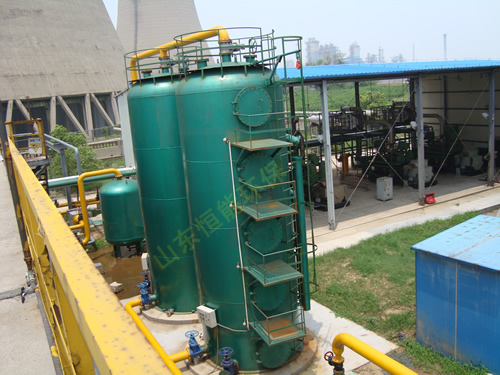廢礦物油是指機動車輛維護,企業在生產經營過程中產生的各種廢油,廢氣,廢物柴油、廢油、真空泵油、廢油、廢熱處理油,齒輪油,廢液壓變壓器油和其他廢物礦物油為基礎的各種潤滑油失去原有的功能和廢棄污泥的石油在石油開采和煉油和石油的過程中,礦物油的沉積物的存儲過程,機械、電力、運輸和其它設備來取代石油和洗油、金屬軋制、加工過程的廢油,含油廢水處理的過程浪費石油和污泥,殘油和過濾器媒體期間生成石油加工和石油都是廢礦物油再生,不適合原來的使用和屬于有毒物質。其中含硫化合物、石油物質和富營養化對水土污染尤為嚴重,在全國危險廢物名錄中名列第八。
Waste mineral oil refers to all kinds of waste oil, waste gas, waste diesel oil, waste oil, vacuum pump oil, waste oil, waste heat treatment oil, gear oil, waste hydraulic transformer oil and other waste mineral oil based on the maintenance of motor vehicles and the production and operation process of enterprises. In the process of oil exploitation, oil refining and oil refining, the mineral oil will sink In the process of storage, machinery, electric power, transportation and other equipment are used to replace the waste oil in the process of oil and wash oil, metal rolling and processing. In the process of oil-bearing wastewater treatment, oil and sludge are wasted. Oil processing and oil generated during the period of residual oil and filter media are both waste mineral oil regeneration, which are not suitable for the original use and belong to toxic substances. Among them, sulfur compounds, petroleum substances and eutrophication are particularly serious to water and soil pollution, ranking eighth in the national list of hazardous wastes.
廢棄礦物油和焦油渣被列為危險廢物,編號為HW08和HW11,是原環境保護總局1999年發布的第11號。5顯然管理辦法規定的危險廢物重復,要求加強危險廢物轉移的有效監督,實施危險廢物轉移系統,要求所有危險廢物必須參考合格單位,和用于將復制的過程管理,從源到結束整個過程監測、預防處置危險廢物是危險和傷害。
Waste mineral oil and tar residue are classified as hazardous wastes, with the numbers of hw08 and hw11, which were issued by the former State Environmental Protection Administration in 1999. It is obvious that the hazardous waste stipulated in the management method is repetitive, which requires strengthening the effective supervision of hazardous waste transfer, implementing the hazardous waste transfer system, requiring all hazardous wastes to refer to the qualified units, and the process management for copying, monitoring the whole process from the source to the end, and preventing the disposal of hazardous wastes from being dangerous and harmful.

廢棄礦物油或焚燒不僅造成嚴重的環境污染,而且造成嚴重的資源浪費。和焦油渣含有苯、酚、萘和其他有毒物質,對人體有致癌作用,如果直接跑到對方或混亂,不僅可以直接影響大氣環境的質量,而且還嚴重污染地下水和土壤環境,屬于危險廢物(HW11),研究表明,一升礦物油基潤滑劑對一百萬升水污染造成的0.1微克/克的礦物油,可減少水介質和小蝦的使用壽命達20%,而礦物油污染地下水達100年之久。事實上,廢棄礦物油的成分不超過2%?10%的變質物質,剩下的90%?98%是可再生和可回收的,焦油殘渣可以用來制造燃料油和瀝青,把廢物變成有價值的資產。特別是汽車4S店廢機油具有很高的回收價值。因此,大力開展廢礦物油和廢焦油渣的回收利用,是提高資源回收效率、保護環境、建設資源節約型社會的重要途徑之一。
Waste mineral oil or incineration not only causes serious environmental pollution, but also causes serious waste of resources. And tar dregs contain benzene, phenol, naphthalene and other toxic substances, which have carcinogenic effect on human body. If they directly run to each other or are confused, they can not only directly affect the quality of the atmospheric environment, but also seriously pollute the groundwater and soil environment. They are hazardous wastes (hw11). Research shows that one liter of mineral oil-based lubricant causes 0.1 μ g / g of mineral oil for one million liters of water pollution, which can reduce the water medium The service life of quality and shrimp is up to 20%, while mineral oil has polluted groundwater for 100 years. In fact, the content of waste mineral oil is not more than 2%? 10% of metamorphic materials, and the remaining 90%? 98% is renewable and recyclable. Tar residue can be used to make fuel oil and asphalt, turning waste into valuable assets. Especially the waste engine oil from 4S shop has a high recycling value. Therefore, it is one of the important ways to improve the efficiency of resource recovery, protect the environment and build a resource-saving society to vigorously carry out the recovery and utilization of waste mineral oil and waste coke oil residue.
據市場研究廢礦物油和焦油渣除了傳統的再生的方法,和一個流動的趨勢是不合理的集中在白土精制,通過精煉方法,廢礦物油破解城市輕燃料油、瀝青焦油渣廢料回收的整個過程浪費,單位產量低,也會產生新的污染,屬于禁止項目。但由于土壤改良技術含量低,進入門檻低,存在一定的需求市場,一直處于反復禁止的狀態。
According to the market research, in addition to the traditional regeneration method, the waste mineral oil and tar residue flow is unreasonable and concentrated in the clay refining. Through the refining method, the waste mineral oil can break the waste of the whole process of the recovery of urban light fuel oil and asphalt tar residue, with low unit output and new pollution, which belongs to the project prohibited by the state. However, due to the low content of soil improvement technology and low entry threshold, there is a certain demand market, which has been in the state of repeated prohibition.
